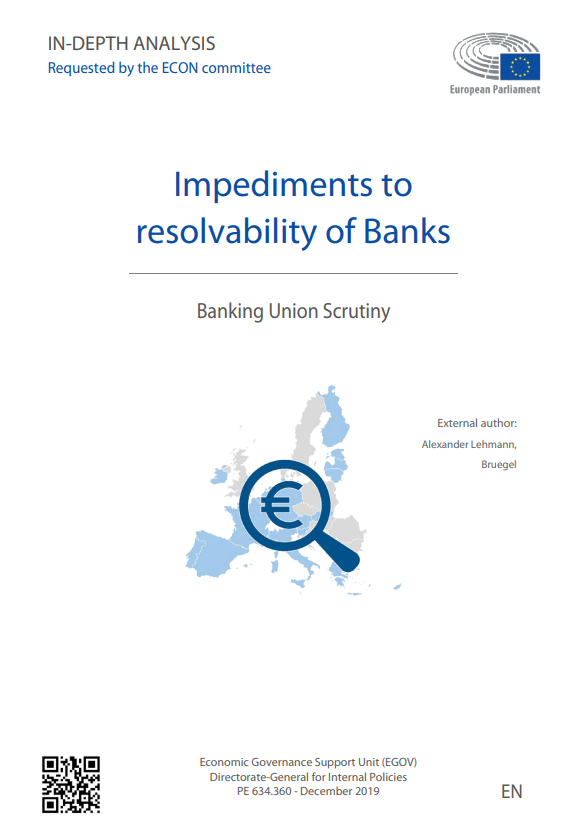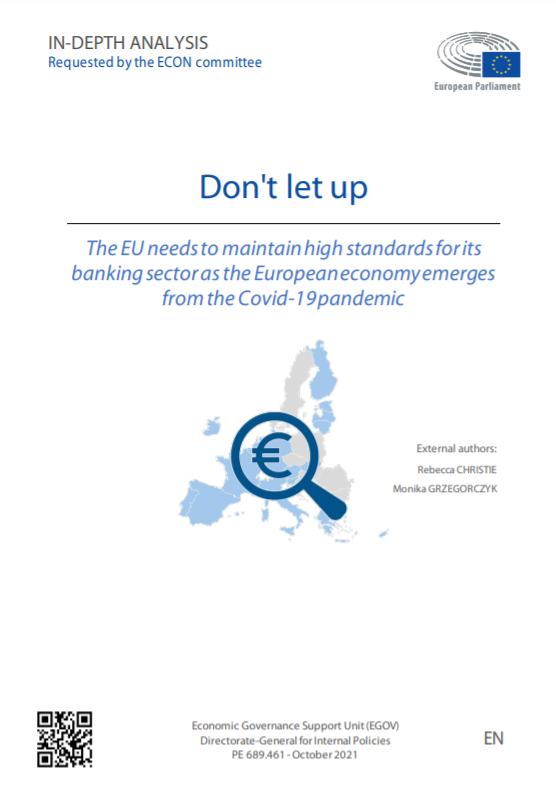External Publication
Impediments to resolvability of banks
This paper gives an overview of the seven aspects of resolvability defined in 2019 by the Single Resolution Board, and then assesses progress in two key areas, based on evidence gathered from public disclosures made by the 20 largest euro-area banks. The largest banks have made good progress in raising bail-in capital. Changes to banks’ legal and operational structures that will facilitate resolution will take more time. Greater transparency would make it easier to achieve the policy objective of making banks resolvable.
In the five years since the adoption of the Bank Recovery and Resolution Directive (BRRD) and the Single Resolution Mechanism Regulation (SRMR), preparations for the orderly failure and resolution of systemically important banks in Europe have made significant progress. Identifying and addressing barriers to resolvability is only now becoming a priority for the Single Resolution Board (SRB).
Making banks resolvable should involve making all the financial, governance and structural preparations necessary to allow liquidations or resolution processes to go ahead without disrupting financial stability or interrupting the banks’ critical functions. Draft SRB guidance to banks issued in October 2019 operationalises this policy objective by describing seven qualities of resolvable banks.
Based on such standards, very few European banks could be described as resolvable. With the possible exception of the European G-SIBs, the deadline for making Europe’s banks resolvable by 2024, which was set in the revised BRRD, is ambitious.
Implementing the SRB’s resolvability standards will require costly reforms in a sector that remains structurally weak. Banks’ ongoing withdrawal from non-core business lines will reduce the burden, but nevertheless upgrades of governance, management processes and business information systems will also be required. Ultimately, concluding that a bank is ‘resolvable’ is unlikely to be a clear-cut decision, nor necessarily a lasting one.
Bond markets have so far absorbed the subordinated debt instruments issued by banks seeking to meet their Minimum Requirement for own funds and Eligible Liabilities (MREL) targets. Constraints on issuance are faced by mid-sized banks which may lack an investor base, and have also emerged in smaller EU countries where bank bond funding is underdeveloped. Rating agencies acknowledge that the senior debt held by a number of European banks has become less risky through this additional loss-absorbing capital, though bail-in securities may be compromised by maturity concentrations and the need to ‘pre-position’ such funding within subsidiary jurisdictions.
Funding of a bank following a resolution process is another aspect of resolvability that is a key concern for investors. The role of the Single Resolution Fund has been clarified in this area, and potential backup funding through the European Stability Mechanism (ESM) may emerge. But preparations by the banks for recovery plans and funding within a resolution appear to be inadequate.
The relative lack of transparency and public disclosures of resolution plans are major obstacles to an effective resolution regime. A requirement for public disclosures could impose market discipline on banks while they are still going concerns, and could promote wider sharing of good practice within the industry. The disclosures from Europe’s 20 largest cross-border banks were reviewed for this briefing and yielded only very limited information about resolution planning.
Interdependencies between business units remain a barrier to resolvability of bank groups that envisage resolution through the partial transfer or sale of their business, or where resolution is envisaged through ‘multiple points of entry’, which would require operationally and financially independent subsidiaries.
This is a particular problem for Europe’s cross-border banks which seek, or are encouraged into, resolution strategies around multiple points of entry. The strategies of key host-country resolution authorities still seem to be not fully aligned with those of the SRB in this regard.






















